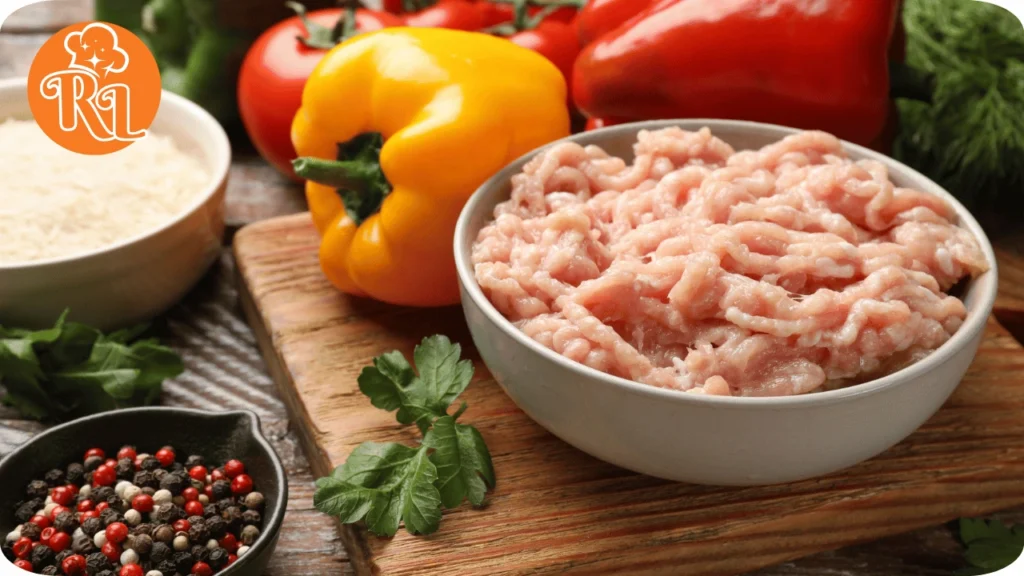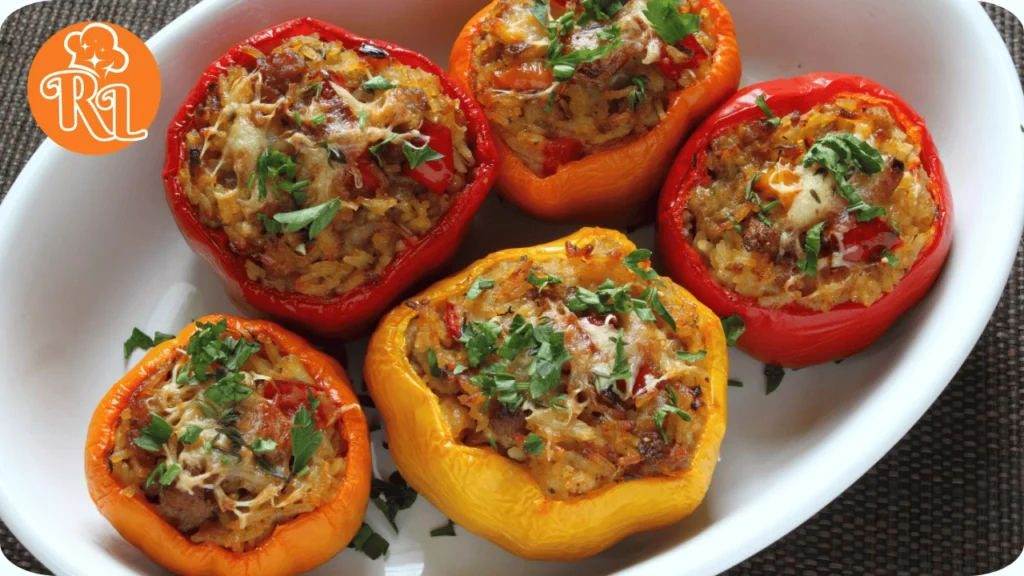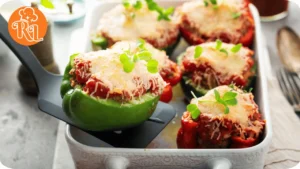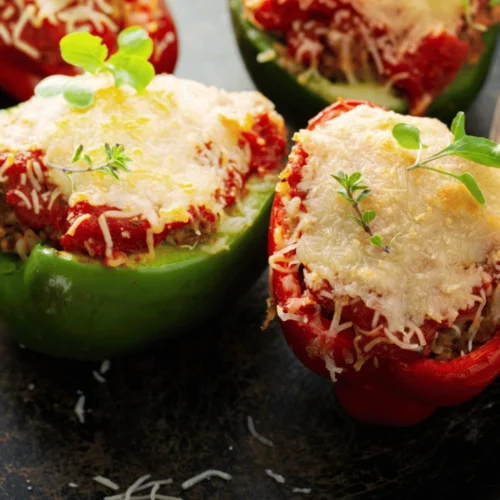Ground beef and rice stuffed peppers are a beloved dish for many families, combining the rich flavors of ground beef, rice, and perfectly roasted peppers.
Stuffed peppers have long been a cherished dish in many households, offering a delightful combination of flavors and textures. Among the countless variations, ground beef and rice stuffed peppers stand out as a quintessential comfort food, embodying simplicity and heartiness. This dish not only pleases the palate but also nourishes the body, making it a staple in family meals across cultures.
In this comprehensive article, we’ll explore the history and origins of stuffed peppers, delve into the process of creating this delectable dish, discuss variations and tips for perfecting your recipe, and even consider the broader culinary context of stuffed foods. Let’s dive into the world of ground beef and rice stuffed peppers!

A Brief History of Stuffed Peppers
Stuffed peppers can be traced back centuries, with origins in various cuisines around the world. The concept of stuffing vegetables has been embraced in numerous cultures, reflecting local ingredients and culinary traditions.
Ancient Beginnings
The practice of stuffing vegetables likely began in the ancient Mediterranean, where bell peppers, eggplants, and zucchinis were filled with mixtures of grains, meats, and spices. As trade routes expanded, ingredients and cooking techniques spread, leading to diverse interpretations of stuffed vegetables.
Cultural Significance
In the United States, stuffed peppers gained popularity in the mid-20th century, particularly during the post-war era. They became a convenient way to utilize leftover ingredients and provide a nutritious meal for families. Ground beef and rice became the standard filling, often enhanced with tomatoes, herbs, and spices, resulting in a dish that was both satisfying and budget-friendly.
Globally, many cultures have their own versions of stuffed peppers. In Mediterranean cuisines, you might find them filled with rice and lamb, while in Eastern European cooking, peppers are often stuffed with a mix of pork and rice, seasoned with paprika. Each variation reflects regional flavors and traditions, highlighting the adaptability of this dish.
The Anatomy of Ground Beef and Rice Stuffed Peppers
At its core, ground beef and rice stuffed peppers consist of three main components: the peppers, the filling, and the sauce. Understanding how these elements work together is key to creating a delicious dish.
The Peppers
Bell peppers are the most common choice for stuffing, thanks to their vibrant colors and sweet flavor. They come in various colors—green, red, yellow, and orange—each offering a slightly different taste profile.
- Green peppers are more bitter and have a firmer texture, while red, yellow, and orange peppers are sweeter and softer. Depending on your preference, you can mix different colors to create an appealing presentation.

When choosing peppers, look for firm, unblemished specimens with a glossy exterior. The size of the peppers can also vary, so consider this when planning your filling amounts.
The Filling
The heart of stuffed peppers is undoubtedly the filling. Ground beef is a classic choice, but the possibilities are nearly endless. The filling typically includes cooked rice, which adds bulk and texture, along with seasonings to enhance flavor.
- Ground Beef: Opt for lean ground beef for a healthier option, or use a mix of beef and other proteins, such as turkey or sausage, for added depth.
- Rice: Both white and brown rice can be used, depending on your dietary preferences. Some variations even incorporate quinoa or cauliflower rice for a lower-carb option.
- Seasonings: Common spices and herbs include garlic, onion, salt, pepper, cumin, and Italian herbs. The combination you choose can significantly alter the flavor profile.
The Sauce
To elevate the dish, many recipes call for a sauce, often made from tomatoes. This adds moisture, enhances the flavor of the filling, and complements the peppers beautifully.
- Tomato Sauce: A classic choice, providing acidity and sweetness. You can use store-bought sauce or make your own by simmering tomatoes with herbs and spices.
- Broth or Stock: Some recipes incorporate broth into the baking process to keep the peppers moist.

Cooking Techniques
The method of preparing stuffed peppers can vary based on personal preference and time constraints. Here are some popular techniques:
Baking
Baking is the most common method for cooking stuffed peppers. This technique allows the peppers to soften while the filling cooks through, resulting in a tender and flavorful dish. The baking process typically involves:
- Pre-cooking the Filling: Sautéing the ground beef and onions, then mixing in cooked rice and seasonings ensures the filling is well-seasoned and fully cooked.
- Stuffing the Peppers: Once the filling is prepared, stuff each pepper generously, packing it in but leaving some room for expansion.
- Baking Time: Place the stuffed peppers in a baking dish, pour sauce over them, cover with foil, and bake until the peppers are tender—usually around 30-40 minutes.
Grilling
For a smoky twist, consider grilling stuffed peppers. This method adds depth and enhances the natural sweetness of the peppers. To grill:
- Prepare the filling as you would for baking.
- Cut the peppers in half and remove the seeds.
- Stuff the halved peppers and secure them with skewers if needed.
- Grill over medium heat, turning occasionally until the peppers are tender.

Variations of Ground Beef and Rice Stuffed Peppers
While the classic ground beef and rice version is a beloved favorite, there are countless variations to explore. Here are a few popular adaptations:
Ground beef and rice stuffed peppers recipe
Equipment
- Large Skillet or Frying Pan: For browning the ground beef and sautéing onions, garlic, and other ingredients for the filling.
- Saucepan: To cook the rice or heat the sauce if you're making it from scratch.
- Cutting Board and Knife: Essential for preparing the bell peppers by cutting off the tops and removing the seeds, as well as for chopping any other vegetables or ingredients.
- Mixing Bowl: For combining the ground beef, cooked rice, and seasonings into a cohesive filling.
- Spoon or Spatula: To stir the filling ingredients together and to scoop the mixture into the peppers.
- Baking Dish or Casserole Dish: To hold the stuffed peppers while baking. A 9×13-inch dish is typically large enough for most recipes.
- Foil: For covering the peppers while baking, ensuring they cook evenly and don't dry out.
- Measuring Cups and Spoons: For accurately measuring ingredients such as rice, seasoning, and sauce.
- Tongs or a Spatula: For carefully handling the stuffed peppers before and after baking.
Ingredients
- Bell Peppers: 4-6 large bell peppers (green, red, yellow, or orange), hollowed out with tops removed.
- Ground Beef: 1 to 1 ½ pounds of lean ground beef (can be substituted with turkey, pork, or a plant-based alternative if desired).
- Cooked Rice: 1 to 1 ½ cups of cooked white or brown rice (or quinoa for a healthier option).
- Onion: 1 medium onion, finely chopped.
- Garlic: 2-3 cloves of garlic, minced.
- Tomato Sauce: 1 to 1 ½ cups of tomato sauce or diced tomatoes (you can also use marinara sauce for extra flavor).
- Cheese: 1 cup of shredded cheese (such as mozzarella, cheddar, or parmesan) for topping the peppers (optional but adds a creamy, delicious layer).
- Olive Oil: 1 tablespoon for sautéing the vegetables.
- Seasonings:
- Salt and black pepper to taste.
- 1 teaspoon of dried oregano or Italian seasoning.
- ½ teaspoon of paprika or chili powder for an added kick (optional).
- Fresh parsley or basil for garnish (optional).
- Broth or Water: ½ to 1 cup of chicken or vegetable broth (optional, for adding to the baking dish to keep the peppers moist while baking).
Instructions
- 1. Prepare the Bell Peppers
- Preheat your oven to 375°F (190°C).
- Cut the tops off the bell peppers and remove the seeds and membranes from inside.
- Rinse the peppers and set them aside. If you want the peppers softer, you can blanch them in boiling water for 2-3 minutes, then drain and set aside.
- 2. Cook the Rice
- If you haven't pre-cooked the rice, cook 1 to 1 ½ cups of rice according to the package instructions. Set it aside once done.
- 3. Prepare the Ground Beef Filling
- In a large skillet, heat 1 tablespoon of olive oil over medium heat. Add the chopped onion and garlic and sauté for about 3-4 minutes until softened.
- Add the ground beef to the skillet and cook until browned, breaking it up with a spoon as it cooks (about 6-8 minutes). Drain any excess fat from the skillet if needed.
- Season the ground beef mixture with salt, pepper, oregano, and paprika
- 4. Stuff the Peppers
- Place the prepared bell peppers upright in a 9×13-inch baking dish.
- Use a spoon to generously fill each pepper with the ground beef and rice mixture, packing it in but leaving a little space at the top.
- 5. Add Sauce and Bake
- Pour the remaining tomato sauce over the tops of the stuffed peppers, making sure some of it drips down into the baking dish.
- Add ½ to 1 cup of broth or water to the bottom of the dish to keep the peppers moist while baking.
- Cover the baking dish with aluminum foil and bake in the preheated oven for 30-35 minutes.
- 6. Add Cheese (Optional)
- After 30-35 minutes, remove the foil and sprinkle the tops of the peppers with shredded cheese (if using). Return the dish to the oven and bake, uncovered, for an additional 10-15 minutes until the cheese is melted and bubbly, and the peppers are tender.
- 7. ServeOnce fully cooked, remove the peppers from the oven and let them cool slightly.
- Garnish with freshly chopped parsley or basil (optional) and serve hot.
- Cooking Tip:
- To check if the peppers are done, use a fork to poke the side. They should be tender but not mushy.
Notes
- Choosing Peppers: Select firm, fresh bell peppers that are free of blemishes. Mixing colors (green, red, yellow, and orange) can add visual appeal and varying flavors.
- Rice Options: While white and brown rice are common, consider using quinoa, cauliflower rice, or wild rice for a healthier twist or different texture.
- Ground Meat Alternatives: Feel free to substitute ground beef with ground turkey, chicken, or plant-based meat alternatives to cater to different dietary preferences.
- Spice Level: Adjust the spice level by adding diced jalapeños or red pepper flakes to the filling for a bit of heat.
- Herbs and Seasonings: Experiment with fresh herbs like basil, parsley, or cilantro to enhance flavor. You can also try adding Worcestershire sauce for depth.
- Cheese Variations: If using cheese, experiment with different types like mozzarella, cheddar, or feta to find your preferred flavor profile.
- Make-Ahead Option: These stuffed peppers can be prepared ahead of time. Assemble them and store in the refrigerator for up to 24 hours before baking.
- Freezing: You can freeze uncooked stuffed peppers. Wrap them individually and store in an airtight container. When ready to cook, bake from frozen, adding extra time as needed.
- Serving Suggestions: Serve with a side salad, garlic bread, or roasted vegetables for a balanced meal.
- Storage: Store leftovers in an airtight container in the refrigerator for up to 3-4 days. Reheat in the oven or microwave before serving.
Here’s a sample nutritional table for Ground Beef and Rice Stuffed Peppers, providing estimates based on a typical serving:
| Nutrient | Per Stuffed Pepper (With Cheese) | Per Stuffed Pepper (Without Cheese) |
|---|---|---|
| Calories | 520 calories | 410 calories |
| Protein | 28g | 26g |
| Total Fat | 24g | 18g |
| Saturated Fat | 10g | 8g |
| Carbohydrates | 45g | 42g |
| Dietary Fiber | 3g | 3g |
| Sugars | 5g | 5g |
| Sodium | 650mg | 600mg |
| Vitamin A | 20% DV | 20% DV |
| Vitamin C | 80% DV | 80% DV |
| Calcium | 15% DV | 10% DV |
| Iron | 15% DV | 15% DV |
Notes:
- DV = Daily Value, based on a 2,000-calorie diet.
- Nutritional values may vary based on specific ingredients and portion sizes.
- Adjustments in ingredients (e.g., leaner meat, different types of rice) can impact nutritional content.
Feel free to customize this table based on your specific recipe!
Vegetarian Stuffed Peppers
For a meatless option, substitute ground beef with plant-based proteins such as lentils, mushrooms, or a combination of vegetables. Add beans for protein and quinoa or brown rice for texture. Seasonings like cumin, chili powder, and smoked paprika can provide a satisfying flavor profile.
Southwestern Style
Incorporate ingredients like black beans, corn, and diced tomatoes for a Southwestern twist. Spice it up with jalapeños or chipotle peppers, and top with cheese before baking for a creamy finish.
Mediterranean-Inspired
For a Mediterranean flair, mix ground beef with feta cheese, olives, and herbs like oregano and basil. Use cooked bulgur or couscous instead of rice, and consider drizzling with olive oil and lemon juice before serving.
Asian-Inspired
Infuse your filling with Asian flavors by incorporating ginger, garlic, and soy sauce. Use jasmine rice instead of regular rice and consider adding vegetables like carrots and green onions for added texture.
Tips for Perfect Stuffed Peppers
Achieving the perfect stuffed peppers involves attention to detail and a few helpful tips:
- Pre-cook the Rice: Use leftover rice or cook it ahead of time. This ensures that your filling comes together quickly and evenly.
- Season Generously: Taste the filling as you go and adjust the seasonings. Remember, the filling should be flavorful on its own since it will be contained within the peppers.
- Don’t Overstuff: While it’s tempting to pack the filling tightly, leave some room at the top for the filling to expand as it cooks.
- Add Moisture: Pouring sauce over the peppers before baking helps keep them moist. If using a dry filling, consider adding a bit of broth to the baking dish.
- Experiment with Cooking Times: Depending on the size of your peppers and the filling, cooking times may vary. Keep an eye on them and check for tenderness.
- Garnish Before Serving: Fresh herbs, grated cheese, or a drizzle of balsamic reduction can elevate the dish just before serving.
The Broader Culinary Context of Stuffed Foods
Stuffed foods are a culinary tradition found in many cultures, showcasing the versatility and creativity of home cooks. Beyond stuffed peppers, numerous dishes feature a similar concept:
- Stuffed Cabbage Rolls: A classic Eastern European dish, where cabbage leaves are filled with a mixture of meat and rice, then simmered in tomato sauce.
- Dolmas: In Mediterranean cuisine, grape leaves are stuffed with rice, herbs, and sometimes meat, often served with a side of yogurt.
- Stuffed Eggplant (Imam Bayildi): A popular dish in Middle Eastern cuisine, eggplants are hollowed out and filled with a savory mixture of onions, tomatoes, and spices.
- Stuffed Squash: Variations include acorn or zucchini squash filled with grains, meats, and vegetables, providing a hearty meal option.
Conclusion: Ground Beef and Rice Stuffed Peppers as a Family Favorite
Ground beef and rice stuffed peppers are more than just a meal; they are a comforting reminder of home and family gatherings. Their rich history and adaptability allow for endless variations, making them a dish that can cater to diverse tastes and dietary preferences. Whether you stick to the classic recipe or venture into new flavors, stuffed peppers are sure to delight both the cook and those who gather around the table.
As you prepare this dish, remember to embrace the process. Cooking is not just about following a recipe; it’s about creating an experience and sharing love through food. So gather your ingredients, invite family or friends, and enjoy the joy of making and sharing ground beef and rice stuffed peppers!


